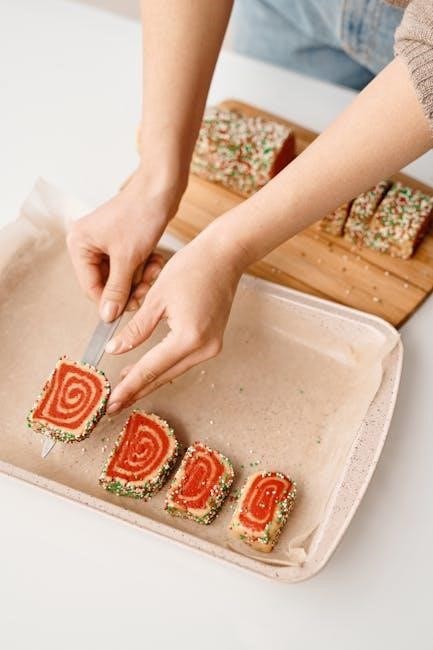Appleton spiral ham is a beloved centerpiece for holidays, offering ease of preparation and delicious results․ Its popularity stems from its tender slices and flavorful glaze options, making it perfect for gatherings․ This guide provides essential tips and techniques to achieve a perfectly cooked, mouthwatering spiral ham every time․
Overview of Spiral Ham Popularity
Spiral hams have become a staple in holiday meals, offering a convenient and flavorful centerpiece for gatherings․ Their popularity stems from ease of serving, as the pre-sliced format ensures minimal effort․ Whether glazed with sweet or savory flavors, spiral hams cater to diverse tastes․ Precooked options further enhance their appeal, making them a stress-free choice for home cooks․ This versatility and convenience have solidified their place as a beloved tradition in many households during Easter, Thanksgiving, and Christmas celebrations․
Importance of Proper Cooking Techniques
Proper cooking techniques ensure a juicy, flavorful spiral ham․ Overcooking can lead to dryness, while undercooking may result in an unappetizing texture․ Maintaining the right temperature and timing is crucial, as it prevents the ham from drying out․ Glazing at the correct stage enhances flavor without burning․ Following guidelines ensures food safety and a delicious outcome, making it essential to adhere to recommended methods for a perfect, stress-free dish every time․
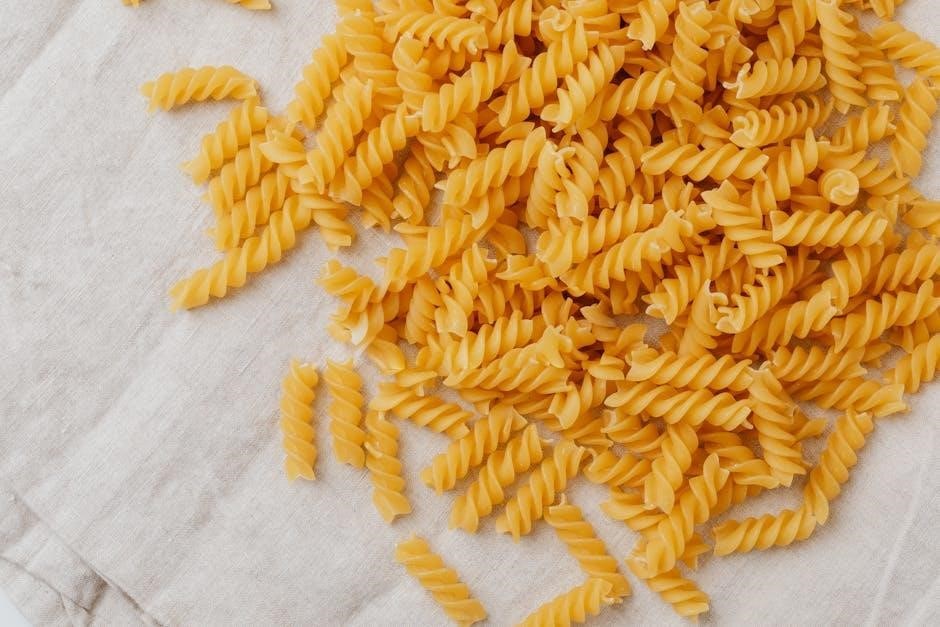
Understanding Appleton Spiral Ham
Appleton Spiral Ham is a pre-cooked, spiral-sliced ham known for its convenience and flavor․ Its pre-cooked nature makes it ready to glaze and serve, while spiral slicing ensures even cooking and easy serving, making it a popular choice for holidays and special events․
What is a Spiral Ham?
A spiral ham is a type of ham that has been pre-sliced into even, thin layers, creating a spiral pattern․ This unique cutting method allows for easy serving and ensures that glazes or seasonings penetrate evenly throughout the meat․ Spiral hams are typically pre-cooked, making them convenient for home cooks who want to achieve a flavorful, tender result with minimal effort․ They are a popular choice for holidays and special occasions due to their presentation and ease of preparation․
Precooked vs․ Uncooked Spiral Hams
Precooked spiral hams are the most common choice, offering convenience as they only require heating․ They are typically smoked or cured, ensuring a tender and flavorful result․ Uncooked spiral hams, while less common, allow for more customization but require longer cooking times․ Precooked hams are ideal for those seeking simplicity, while uncooked hams cater to those who prefer a more personalized cooking experience․ Both options provide delicious results when prepared correctly, making them versatile for various culinary preferences and occasions․
Key Features of Appleton Spiral Ham
Appleton Spiral Ham is a popular choice for its convenience and flavor․ It is typically pre-glazed, offering a sweet and savory taste․ The spiral slicing ensures even cooking and easy serving․ This ham is known for its tender texture and rich aroma․ It is often pre-cooked, making it a hassle-free option for home cooks․ The ham’s compact size and balanced seasoning make it ideal for both small gatherings and large celebrations․ Its versatility allows it to be cooked in various methods, ensuring a delicious result every time․
Tools and Ingredients Needed
Essential tools include a roasting pan with a rack, meat thermometer, and basting brush․ Ingredients like brown sugar, pineapple juice, honey, and spices create a delicious glaze․
Essential Kitchen Tools for Cooking Spiral Ham
Cooking spiral ham requires a roasting pan with a rack to ensure even heating․ A meat thermometer is crucial for monitoring internal temperature․ Use a basting brush to apply glaze evenly․ Aluminum foil helps retain moisture during cooking․ A sharp knife is needed for slicing, and oven mitts protect hands from burns․ Optional tools include a slow cooker for hands-off preparation or a microwave-safe dish for reheating glazes․ These tools ensure a perfectly cooked and presented spiral ham․
Common Ingredients for Glazes and Seasonings
Popular glaze ingredients include brown sugar, honey, Dijon mustard, and pineapple juice for a sweet and tangy flavor․ Spices like cinnamon, cloves, and nutmeg add warmth, while a hint of vinegar balances the sweetness․ For a savory touch, garlic, onion powder, or smoked paprika can be used․ These ingredients create a rich, sticky glaze that enhances the ham’s natural flavor․ Experimenting with combinations allows for a personalized taste, making each spiral ham uniquely delicious․
Cooking Methods for Spiral Ham
Spiral ham can be cooked via oven roasting, slow cooker, or microwave․ Each method offers unique convenience and flavor, ensuring a delicious result every time․
Oven Roasting: A Classic Method
Oven roasting is a timeless way to cook spiral ham, offering even heating and a caramelized glaze․ Preheat your oven to 250-275°F, place the ham sliced side down, and roast for 12-15 minutes per pound․ Score the fat layer in a diamond pattern for glaze penetration․ Apply your chosen glaze during the last 20-30 minutes of cooking․ Let the ham rest for 10-15 minutes before slicing to ensure juices redistribute, resulting in a tender, flavorful dish with a perfectly glazed crust․
Slow Cooker: A Hands-Off Approach
Cooking spiral ham in a slow cooker offers a convenient, low-maintenance method․ Place the ham in the slow cooker, fat side up, and cook on low for 3-4 hours or until heated through․ Glaze the ham during the last 30 minutes of cooking for a caramelized finish․ This method ensures a moist, flavorful ham with minimal effort, perfect for busy households or large gatherings․ Let it rest before slicing for the best results․
Microwave Heating: Quick and Easy
Microwave heating offers a fast and convenient way to cook spiral ham․ Place the ham in a microwave-safe dish, cover it with plastic wrap, and heat on medium power for 2-3 minutes per pound․ Check the internal temperature, aiming for 140°F․ Glaze the ham during the last minute of heating for a sweet, caramelized finish․ Let it rest for 5 minutes before slicing․ This method is ideal for small portions or when time is limited, ensuring a juicy and flavorful result with minimal effort․

Glazing and Seasoning Techniques
Glazing and seasoning are crucial for enhancing the flavor and appearance of Appleton spiral ham․ Apply the glaze during the last 20 minutes of cooking to prevent burning․ For a sweet touch, heat the remaining glaze in the microwave and serve alongside․ Experiment with herbs or spices for a savory twist, ensuring a deliciously balanced taste․
Popular Glaze Recipes for Spiral Ham
A classic brown sugar glaze, mixed with pineapple juice and mustard, adds a sweet and tangy flavor․ For a fruity twist, combine brown sugar, caramelized pineapple, and cherries․ Honey-bourbon and maple-mustard glazes offer rich, savory options․ These recipes enhance the ham’s natural taste, creating a caramelized crust․ Apply the glaze during the last 20 minutes of cooking to avoid burning․ Experiment with these popular choices to find your perfect flavor combination for a deliciously glazed spiral ham․
When to Apply the Glaze
The glaze should be applied during the last 20-30 minutes of cooking to prevent burning and ensure a caramelized finish․ For oven-roasted hams, brush the glaze evenly over the surface after removing the ham from the oven․ If using a slow cooker, apply the glaze during the final 30 minutes of heating․ Always warm the glaze slightly before applying to ensure it spreads smoothly and adheres well to the ham․ This step enhances flavor and texture, making the ham more appealing for serving․
Alternative Seasoning Options
Beyond traditional glazes, explore unique seasoning options to elevate your spiral ham․ Try pineapple rings paired with cherries for a fruity twist or a honey-apricot glaze for sweetness․ For a savory touch, sprinkle with herbs like rosemary or thyme․ Spices such as cumin or paprika add a smoky depth․ These alternatives allow you to customize the ham’s flavor profile, ensuring a dish that stands out at any gathering․ Experiment with combinations to create a taste that suits your preferences perfectly․

Temperature and Timing Guidelines
Preheat your oven to 250-275°F for spiral ham․ Cook 10-15 minutes per pound until the internal temperature reaches 140°F․ Ensure even heating for optimal results․
Internal Temperature Requirements
The internal temperature of a spiral ham must reach 140°F for safe consumption․ Use a meat thermometer to check the thickest part, avoiding bone contact․ Preheat your oven to 250-275°F and cook 10-15 minutes per pound; Ensure consistent heat by not opening the oven excessively․ Proper temperature control prevents undercooking and ensures a juicy, flavorful ham․ Always prioritize food safety with accurate temperature monitoring․
Recommended Cooking Time per Pound
Cooking time for spiral ham is typically 10-15 minutes per pound at 250-275°F․ For a 10-pound ham, this translates to 100-150 minutes․ Always use a meat thermometer to ensure the internal temperature reaches 140°F․ To enhance flavor, apply the glaze during the last 30 minutes of cooking․ This method ensures a tender, caramelized finish․ Adjust timing slightly for larger or smaller hams, and let the ham rest before slicing for optimal juiciness and presentation․
Resting Time After Cooking
After cooking, allow the spiral ham to rest for 10-15 minutes before slicing․ This step is crucial as it lets the juices redistribute, ensuring tender and flavorful meat․ Tenting the ham with foil during resting helps retain heat without drying it out․ A well-rested ham slices cleanly and evenly, making it easier to serve․ This brief waiting period enhances both texture and presentation, guaranteeing a delicious and stress-free dining experience for your guests․
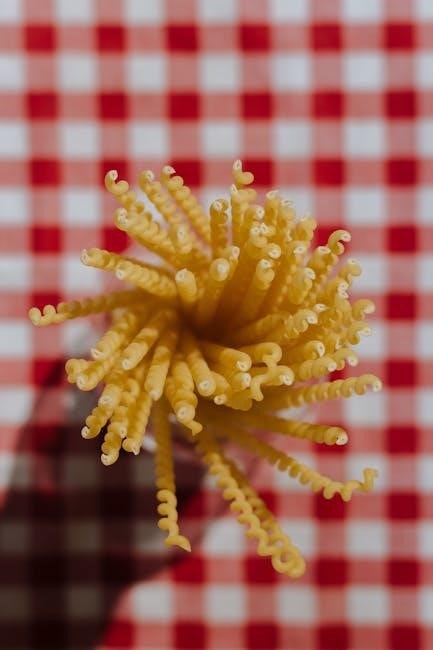
Serving and Presentation Tips
Slice the spiral ham thinly against the grain for tender portions․ Arrange on a decorative platter with fresh herbs or fruit for a festive look․ Serve alongside complementary side dishes like roasted vegetables or mashed potatoes to enhance the meal’s appeal․ Garnish with pineapple slices or cherries for added visual flair, ensuring a memorable and appetizing presentation for your guests․
How to Slice Spiral Ham Properly
To slice spiral ham, place it on a stable surface with the cut side down․ Use a sharp knife to cut along the natural lines of the pre-sliced sections․ Slice thinly and evenly, ensuring each piece is uniform for consistent serving․ For bone-in hams, carefully navigate around the bone to avoid waste․ Let the ham rest for 10-15 minutes before slicing to retain juices․ This method ensures tender, flavorful slices that are easy to serve and enjoy;
Side Dishes to Pair with Spiral Ham
Spiral ham pairs perfectly with classic sides like mashed potatoes, roasted vegetables, or a fresh green salad․ Pineapple rings and cherries add a sweet contrast, while warm dinner rolls or biscuits complement the savory flavors․ For a festive touch, consider glazed carrots, creamy coleslaw, or sweet potato casserole․ These dishes enhance the ham’s rich taste and create a well-rounded, satisfying meal for any occasion․
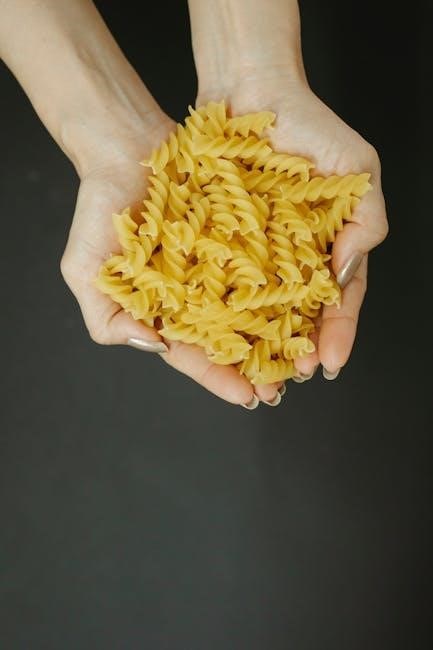
Garnishing Ideas for a Festive Look
Elevate your spiral ham’s presentation with fresh herbs like rosemary or thyme, arranged around the platter․ Pineapple rings and maraschino cherries add a pop of color and sweetness․ For a rustic touch, place the ham on a bed of fresh greens or sliced fruit․ A drizzle of glaze over the ham and garnish with edible flowers or pomegranate seeds creates a stunning centerpiece․ These simple yet elegant ideas ensure your spiral ham stands out as the star of any festive meal․
Storage and Reheating Instructions
Store spiral ham in the refrigerator at 40°F or below before cooking․ For reheating, place ham in the oven at 275°F, glazing during the last 20 minutes․ Ensure internal temperature reaches 140°F for food safety․
Storing Spiral Ham Before Cooking
Store spiral ham in its original packaging in the refrigerator at 40°F or below․ Keep it sealed to maintain moisture and flavor․ If freezing, wrap tightly in plastic wrap or aluminum foil and store at 0°F for up to 6 months․ Thaw frozen ham in the refrigerator, allowing 24 hours per 4 pounds․ Place ham on a tray to catch juices during thawing․ Always ensure the ham remains cold to prevent bacterial growth․ Proper storage ensures freshness and safety before cooking․
Reheating Cooked Spiral Ham
To reheat a cooked spiral ham, preheat your oven to 275°F․ Wrap the ham tightly in foil and place it in a roasting pan․ Heat for 10-15 minutes per pound, or until the internal temperature reaches 140°F․ For a glaze, brush it on during the last 20 minutes of heating․ Alternatively, use a slow cooker on low for 2-3 hours or microwave slices for 20-30 seconds per slice․ Ensure the ham is covered to retain moisture and flavor․ Proper reheating ensures a juicy, delicious result every time․
Freezing and Thawing Guidelines
For long-term storage, wrap the spiral ham tightly in plastic wrap or aluminum foil and place it in a freezer-safe bag․ Freeze at 0°F or below for up to 6 months․ To thaw, transfer the ham to the refrigerator 2-3 days before cooking․ For faster thawing, submerge in cold water, changing the water every 30 minutes․ Never thaw at room temperature to prevent bacterial growth․ Proper freezing and thawing ensure the ham retains its flavor and texture for a delicious meal when you’re ready to cook it․

Food Safety Considerations
Always handle spiral ham safely to prevent contamination․ Store at 40°F or below, and cook to an internal temperature of 140°F․ Check for spoilage signs like a sour smell or slimy texture before cooking․
Handling and Hygiene Tips
Always wash your hands thoroughly before and after handling the spiral ham․ Use clean utensils and cutting boards to prevent cross-contamination․ Store the ham at 40°F or below to maintain freshness․ When thawing, place it in a leak-proof bag on the bottom shelf of the refrigerator․ Never thaw at room temperature․ Ensure the ham reaches an internal temperature of 140°F during cooking․ Check for signs of spoilage, such as a sour smell or slimy texture, before cooking․ Proper handling ensures a safe and enjoyable dining experience․
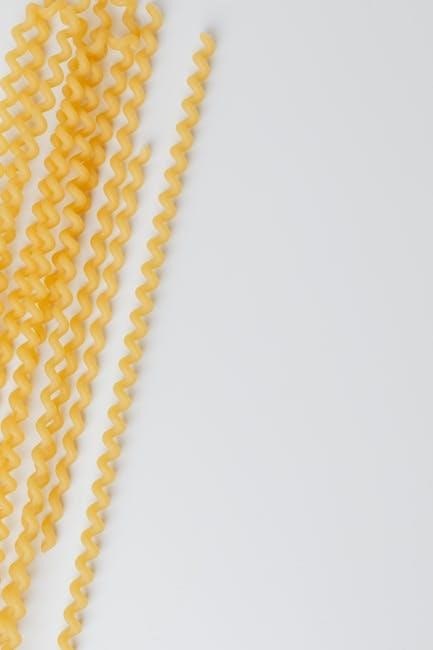
Signs of Spoilage to Watch For
Check for visible mold, a slimy texture, or discoloration on the ham’s surface․ A sour or unpleasant odor is a clear sign of spoilage․ If the ham feels sticky or develops an off smell, it should not be cooked or consumed․ Always ensure the ham is stored properly at 40°F or below to prevent spoilage․ If in doubt, err on the side of caution and discard the ham to avoid foodborne illness․ Freshness is crucial for safety and flavor․
Troubleshooting Common Issues
Prevent drying by tenting with foil and using lower heat․ Fix overly salty ham by rinsing and soaking in water before cooking․ Adjust glaze timing to avoid over-caramelization․
Preventing Drying Out of the Ham
To keep your Appleton spiral ham moist, tent it with foil during cooking, especially in the oven․ Use a lower temperature (around 250-275°F) and shorter cooking times to prevent overcooking․ Baste the ham with pan juices or additional glaze periodically to retain moisture․ Avoid overheating, as this can dry out the meat․ Ensure the ham is covered during resting to lock in juices․ These steps ensure a tender, juicy result every time․
Fixing a Too-Salty Ham
If your Appleton spiral ham turns out too salty, balance the flavor by glazing it with a sweet or tangy sauce, like honey, brown sugar, or pineapple juice․ This counteracts the saltiness․ Avoid adding more salt during cooking or glazing․ Serve with sides like fresh fruit or unsalted vegetables to neutralize the flavor․ For extreme cases, soak the ham in water for 30 minutes before cooking to draw out excess salt․ Always taste before serving to adjust seasoning if needed․
Variations and Substitutions
Explore alternative cooking methods like slow cooking or oven roasting for unique textures․ Substitute glaze ingredients with honey, maple syrup, or spices for a personalized flavor profile․
Cooking a Boneless Spiral Ham
Cooking a boneless spiral ham requires attention to moisture and flavor retention․ Preheat your oven to 250°F and bake for 12-15 minutes per pound, wrapping in foil to prevent drying․ Apply your preferred glaze during the last 20 minutes of cooking to enhance flavor․ For a tender result, ensure the internal temperature reaches 140°F․ This method ensures a juicy, evenly cooked ham perfect for any occasion, with minimal effort and maximum flavor․
Using Alternative Sweeteners in Glazes
For a unique twist, try using alternative sweeteners like honey, maple syrup, or agave nectar in your spiral ham glaze․ These options add distinct flavors while catering to dietary preferences․ When substituting, reduce the amount by about 25% since they are sweeter than traditional sugars․ Mix with spices like cinnamon or cloves for a balanced taste․ Apply the glaze during the last 20 minutes of cooking to ensure it caramelizes perfectly without burning․ This method offers a creative way to enhance your ham’s flavor profile while accommodating various tastes and dietary needs․
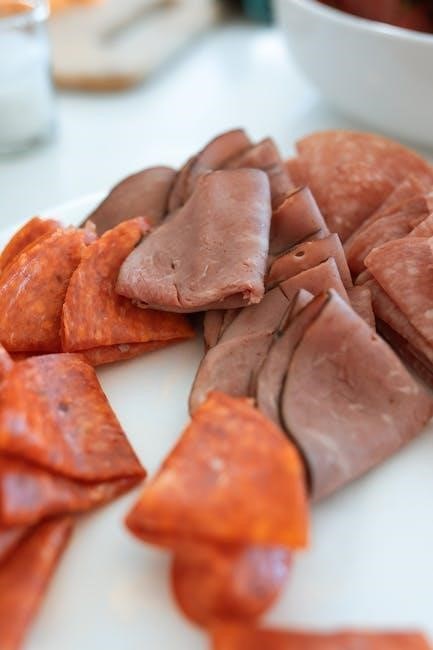
Special Occasion Cooking Tips
For holidays, heat glazed ham at 250F for 12-15 minutes per pound․ Apply glaze during the last 20 minutes to ensure a caramelized finish and juicy texture․
Cooking for Large Gatherings
For large gatherings, calculate the ham size based on guests, ensuring 1/2 pound per person․ Preheat the oven to 250F and place the ham on a rack in a roasting pan․ Wrap it in foil to maintain moisture and bake for 12-15 minutes per pound․ Uncover the ham during the last 20 minutes to apply the glaze, ensuring a caramelized finish․ Use a slow cooker as an alternative for hands-off cooking․ Let the ham rest 10-15 minutes before slicing for optimal juiciness and even distribution of flavors․
Timing the Ham for Holiday Meals

Plan your spiral ham cooking to ensure it’s ready for your holiday meal․ Preheat the oven to 250F and bake for 12-15 minutes per pound․ Apply the glaze during the last 30 minutes of cooking․ For a precooked ham, heat it until the internal temperature reaches 140F․ Allow the ham to rest for 10-15 minutes before slicing to retain juices․ Start cooking 2-3 hours before serving to align perfectly with your holiday schedule and ensure a stress-free, delicious centerpiece for your gathering․
Cooking Appleton spiral ham is a breeze with proper techniques․ Ensure the internal temperature reaches 140F for safety and flavor․ Enjoy your perfectly glazed, juicy ham at gatherings!
Final Tips for Perfect Spiral Ham
For a flawless spiral ham, ensure the internal temperature reaches 140°F․ Use a meat thermometer for accuracy․ Apply glaze during the last 20-30 minutes of cooking to prevent burning․ Let the ham rest for 10-15 minutes before slicing to retain juices․ Avoid overcooking, as it can dry out the meat․ Consider using a slow cooker for a hands-off, moist result․ Experiment with glaze flavors like brown sugar or pineapple for a unique twist․ Always follow safe food handling practices to enjoy a delicious, stress-free meal․
Encouragement to Experiment and Enjoy
Embrace the versatility of Appleton spiral ham by exploring creative glazes and seasonings․ Try honey-mustard, brown sugar, or herb-crusted variations for a unique flavor․ Don’t hesitate to pair the ham with fresh fruits, nuts, or cheeses for a stunning presentation․ Remember, cooking is an art, so enjoy the process and share the joy of a perfectly cooked spiral ham with family and friends․ Make every meal special with your personal touch and savor the delicious results!
